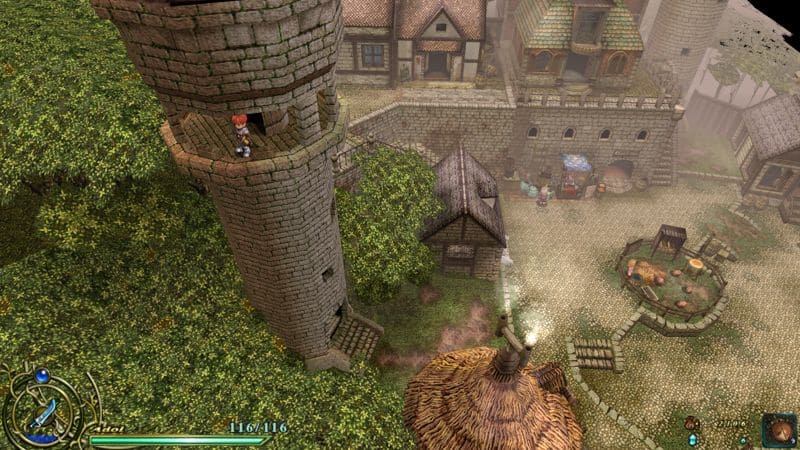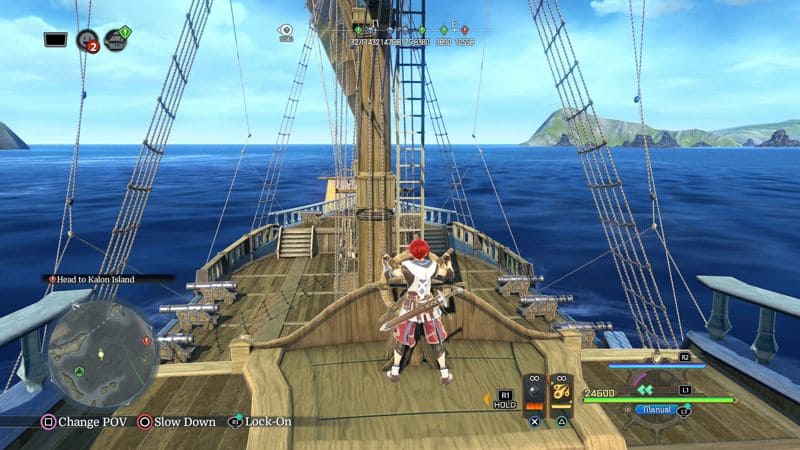In 1987, developer Nihon Falcom released Ancient Ys Vanished for the PC-8800. Its immediate sequel, Ancient Ys Vanished – The Final Chapter, was released for the PC-8801 a year later. Over the years since these classic titles, the series has changed and evolved in many ways. With a new game releasing this month and a remake coming to the West next year, let’s take a look at all the ways the series has changed since the first game.
Experimenting With the Formula
After Ancient Ys Vanished – The Final Chapter, Falcom released Wanderers From Ys in 1989, also for the PC-8801. Where the first two games were top-down games using bump combat, Wanderers From Ys used a sidescroller camera and featured platforming elements. Another change to this game was the combat, with a dedicated attack button much like the Zelda series. Many of the changes in Wanderers From Ys did not carry over into future games. However, the dedicated attack button would become a staple of the series going forward.
In 1993, two versions of the fourth game in the series were released. One was Mask of the Sun, developed by Tonkin House, and the other was The Dawn of Ys, developed by Hudson Soft. As the story goes, Falcom had a design document for what IV would look like, but they didn’t have enough people at the studio to make that concept a reality. Instead, they gave the design document to Tonkin and Hudson and licensed both versions of the game. Both Mask of the Sun and Dawn of Ys returned to the gameplay style of the first two games, including bump combat.
Kingdom of Sand
Lost Kefin, Kingdom of Sand was released for the Super Famicom in 1995. It combines Wanderers From Ys‘ dedicated attack button with the top-down perspective of the first two games, while also giving Adol the ability to jump and use a shield. The central mechanic of Lost Kefin, Kingdom of Sand is its alchemy, though in terms of gameplay, it plays very similarly to the magic system in the first two games.
Entering the Third Dimension

After the poor reception of Lost Kefin, Kingdom of Sand, Falcom released remakes of the first two games and focused on their other IPs. During this time, they also moved away from developing for consoles, instead developing solely for Windows. Finally, in 2003, they released The Ark of Napishtim for Windows. The Ark of Napishtim uses 3D models for environments, characters, and enemies, but with a fixed camera that harkens back to prior games’ top-down perspective. In the game, Adol can jump like in Lost Kefin, Kingdom of Sand, as well as find magical artifacts that let him use elemental attacks.
In 2005, Falcom released The Oath in Felghana, also for Windows. It used the same engine as The Ark of Napishtim, commonly called the Napishtim engine. The game is a remake of Wanderers From Ys, in response to the original game’s mixed reception. Rather than the side-scrolling perspective and platforming focus of Wanderers From Ys, The Oath in Felghana features the mechanics and systems common to the Napishtim engine games. It does retain some of the platforming of the original game, but it isn’t as prevalent.
Origin
The next entry in the mainline series was Ys Origin in 2006. Also using the Napishtim engine and released for Windows, it is a prequel to the first two games in the series, taking place 700 years before the events of the first game. Instead of featuring Adol as its protagonist, Origin features three protagonists: Yunica Tovah, Hugo Fact, and Toal Fact. Each protagonist has their own story campaign, with variations between the three in how events play out. They also have different gameplay styles. Yunica wields a battle axe, Hugo uses magic, and Toal attacks with the metal claws he is nicknamed for.
The Modern Games
2009 saw the release of Ys Seven, which featured a new engine and was the series’ return to being developed for consoles. This game introduced the damage-type mechanic seen in modern games in the franchise, as well as party members. Rather than switching between magical artifacts, party members join Adol on his adventure, including Dogi. Each party member has one of three damage types, though Adol’s ultimate weapon converts his damage type from Slash to All. Some enemies are weak to certain damage types, taking less damage from the other two types. Seven also introduced a skill system and Extra Skills.
Memories of Celceta, Falcom’s canonical version of the Ys IV story, was released in 2012 for the PlayStation Vita. It used the Seven engine and introduced bonuses for having certain party compositions. This is the game that introduced SP bonuses for defeating enemies in certain ways, such as the Aerial Bonus for defeating an enemy while it’s airborne. Each party member has a unique ability that can only be used when they are the party leader, from Adol being able to recover his lost memories to another party member being able to open locked chests.
Lacrimosa of Dana
In 2016, Falcom released Lacrimosa of Dana for the PlayStation Vita. It iterated upon the gameplay of Seven and Memories of Celceta, refining the damage type mechanic to give greater rewards for attacking enemies with the type they’re weak to. Lacrimosa of Dana is also the first game in the series to allow the player to freely control the camera, as well as the first in the series to feature dual protagonists. The 2018 PC port of the game received an experimental update in 2020 that added co-op multiplayer.
The Future

Falcom released Monstrum Nox in 2019 for PlayStation 4. Monstrum Nox improves upon the mechanics of Lacrimosa of Dana, including making the window to execute a Flash Guard more lenient. It also employs a much more open and vertical-level design, with the city of Balduq being for the most part fully open after all regions have been unlocked. The central new mechanic of Monstrum Nox is the Monstrum Gifts, which act as traversal abilities.
Nordics
While Nordics will be released in the West later this month, it was released in Japan last year. It seems to be iterating upon the mechanics and systems of Monstrum Nox, with the inclusion of a boat Adol can steer and participate in naval battles with. The three new mechanics shown for Nordics are the Cross Action system, the Mana Actions system, and the Release Lines system.
Final Thoughts
The Ys series has grown and changed a lot since the release of Ancient Ys Vanished. From 2D top-down pixel art to full 3D, from individual levels to something closer to an open world. With Nordics featuring naval battles, and possibly only two party members, where might the series go in the future? Falcom has a long history of iterating on previous games and implementing the feedback of players and reviewers to improve newer games. The company’s president has also mentioned wanting to remake Lost Kefin, Kingdom of Sand, though so far there haven’t been any announcements of such a remake.
For More Great Content
Craving top-tier content that covers it all? From electrifying sports highlights and insider entertainment news to expert gaming tips and sharp betting advice, we’ve got you covered. Dive into our curated articles to stay ahead of the game with the latest sports action, uncover the hottest trends in entertainment, and get the lowdown on gaming strategies that could level up your play. Plus, our betting advice will sharpen your edge and boost your chances of winning big. Whether you’re looking to stay updated or gain a competitive edge, our content is your go-to source for all things exciting and relevant. Don’t miss out—explore now and power up your knowledge! Follow us on Twitter/X @TotalApexSports, to stay informed.

